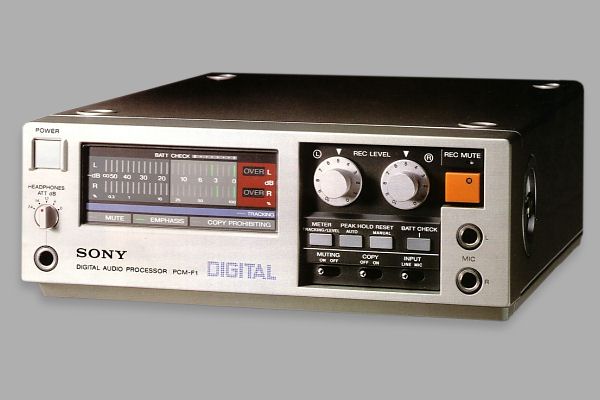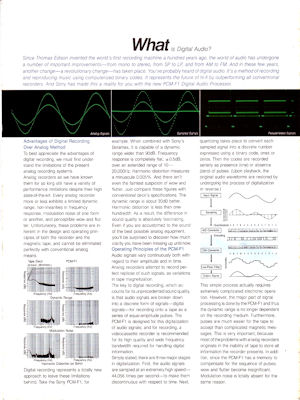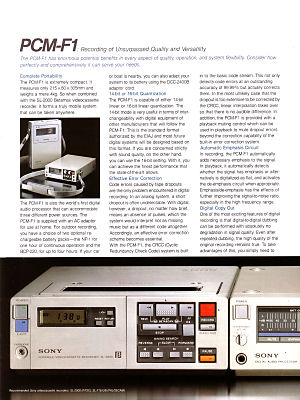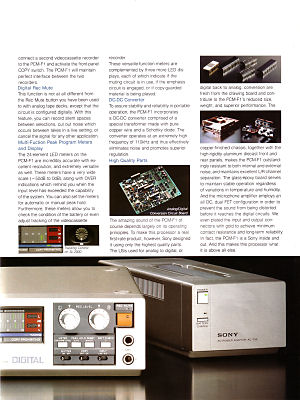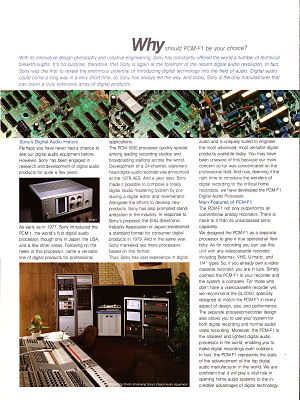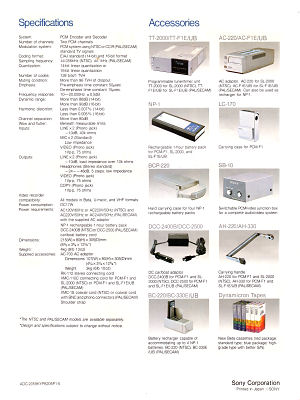Overview
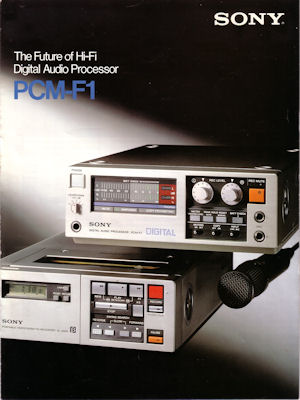
|
The PCM-F1 is a digital audio processor, normally connected to the SL-F1 or the SL-2000
Portable Betamax Videocassette-Recorders. So what is PCM?
The build quality of this range of units was exceptionally good. The electronics rarely fail and are often still found in full working order today.
At the time, SONY produced the following advertising brochure for the PCM-F1 explaining this radical and visionary new technology of the time:
The Future of Hi-Fi
Digital Audio Processor PCM-F1 What is Digital Audio?Since Thomas Edison invented the world's first recording machine a hundred years ago, the world of audio has undergone a number of important improvements�from mono to stereo, from SP to LP, and from AM to FM. And in these few years, another change�a revolutionary change�has taken place. You've probably heard of digital audio. It's a method of recording and reproducing music using computerized binary codes. It represents the future of hi-fi by outperforming all conventional recorders. And Sony has made this a reality for you with the new PCM-F1 Digital Audio Processor.Advantages of Digital Recording Over Analog MethodTo best appreciate the advantages of digital recording, we must first under�stand the limitations of the present analog recording systems.Analog recorders as we have known them for so long still have a variety of performance limitations despite their high state-of-the-art. Every analog recorder more or less exhibits a limited dynamic range, non-linearities in frequency response, modulation noise of one form or another, and perceptible wow and flutter. Unfortunately, these problems are in�herent in the design and operating prin�ciples of both the recorder and the magnetic tape. and cannot be eliminated perfectly with conventional analog means. Digital recording represents a totally new approach to leave these limitations behind. Take the Sony PCM-F1, for example. When combined with Sony's Betamax. it is capable of a dynamic range wider than 90dB. Frequency response is completely flat, �0.5dB,. over an extended range of 10�20.000Hz. Harmonic distortion measures a minuscule 0.005%. And there isn't even the faintest suspicion of wow and flutter. Just compare these figures with conventional deck's specifications. The dynamic range is about 30dB better. Harmonic distortion is less than one-hundredth. As a result, the difference in sound quality is absolutely fascinating. Even if you are accustomed to the sound of the best possible analog equipment, you'll be surprised to discover how much clarity you have been missing up until now. Operating Principles of the PCM-F1 Audio signals vary continuously both with regard to their amplitude and in time. Analog recorders attempt to record per�fect replicas of such signals, as variations in tape magnetization. The key to digital recording, which ac�counts for its unprecedented
sound quality, is that audio signals are broken down into a discrete
form of signals Simply stated there are three major stages in digitalization. First, the audio signals are sampled at an extremely high speed − 44,056 times per second − to make them discontinuous with respect to time. Next, quantizing takes place to convert each sampled signal into a discrete number expressed using a binary code, ones or zeros. Then the codes are recorded serially as presence (one) or absence (zero) of pulses. (Upon playback, the original audio waveforms are restored by undergoing the process of digitalization in reverse.) This simple process actually requires extremely complicated electronic opera�tion. However, the major part of signal processing is done by the PCM-F1 and thus the dynamic range is no longer dependent on the recording medium. Furthermore, pulses are much easier for the tape to accept than complicated magnetic mes�sages. This is very important, because most of the problems with analog recorders originate in the inability of tape to store all information the recorder presents. In addi�tion, since the PCM-F1 has a memory to compensate for the sequence of pulses, wow and flutter become insignificant. Modulation noise is totally absent for the same reason. PCM-F1 Recording of Unsurpassed Quality and VersatilityThe PCM-F1 has enormous potential benefits in every aspect of quality, operation, and system flexibility. Consider how perfectly and comprehensively it can serve your needs.Complete PortabilityThe PCM-F1 is extremely compact. It measures only 215 x 80 x 305mm and weighs a mere 4kg. So when combined with the SL-2000 Betamax videocassette recorder. it forms a truly mobile system that can be taken anywhere.The PCM-F1 is also the world's first digital audio processor that can accommodate three different power sources. The PCM-F1 is supplied with an AC adaptor for use at home. For outdoor recording, you have a choice of two optional rechargeable battery packs�the NP-1 for one hour of continuous operation and the BCP-220, for up to four hours. If your car or boat is nearby, you can also adapt your system to its battery using the DCC-2400B adaptor cord. 14-bit or 16-bit QuantizationThe PCM-F1 is capable of either 14-bit linear or 16-bit linear quantization. The 14-bit mode is very useful in terms of interchangeability with digital equipment of other manufacturers that will follow the PCM-F1: This is the standard format authorized by the EIAJ and most future digital systems will be designed based on this format. If you are concerned strictly with sound quality on the other hand, you can use the 16-bit setting. With it, you can achieve the finest performance that the state-of-the-art allows.Effective Error CorrectionCode errors caused by tape dropouts are the only problem encountered in digital recording. In an analog system, a short dropout is often undetectable. With digital, however, a dropout, no matter how brief, means an absence of pulses, which the system would interpret not as missing music but as a different code altogether. Accordingly, an effective error correction scheme becomes essential.With the PCM-F1, the CRCC (Cyclic Redundancy Check Code) system is built in to the basic code stream. This not only detects code errors at an outstanding accuracy of 99.99% but actually corrects them. In the most unlikely case that the dropout is too extensive to be corrected by the CRCC, linear interpolation takes over so that there is no audible difference. In addition, the PCM-F1 is provided with a playback muting control which can be used in playback to mute dropout errors beyond the correction capability of the built-in error correction system. Automatic Emphasis CircuitIn recording, the PCM-F1 automatically adds necessary emphasis to the signal. In playback, it automatically detects whether the signal has emphasis or alternatively is digitalized as flat, and activates the de-emphasis circuit when appropriate. Emphasis/de-emphasis has the effects of further improving the signal-to-noise ratio, especially in the high frequency range.Digital Copy OutOne of the most exciting features of digital recording is that digital-to-digital dubbing can be performed with absolutely no degradation in signal quality. Even after repeated dubbing, the high quality of the original recording remains true. To take advantages of this, you simply need to connect a second videocassette recorder to the PCM-F1 and activate the front-panel COPY switch. The PCM-F1 will maintain perfect interface between the two recorders.Digital Rec MuteThis function is not at all different from the Rec Mute button you have been used to with analog tape decks, except that the circuit is configured digitally. With this feature, you can record silent spaces between selections, cut out noise which occurs between takes in a live setting, or cancel the signal for any other application.Multi-Function Peak Program Meters and DisplayThe 24-element LED meters on the PCM-F1 are incredibly accurate with excellent resolution and extremely versatile as well. These meters have a very wide scale (-50dB to 0dB) along with OVER indications which remind you when the input level has exceeded the capability of the system. You can also set the meters for automatic or manual peak hold. Furthermore, these meters allow you to check the condition of the battery or even adjust tracking of the videocassette recorder.These versatile-function meters are complemented by three more LED displays, each of which indicates if the muting circuit is in use, if the emphasis circuit is engaged or if copy-guarded material is being played. DC-DC ConverterTo assure stability and reliability in portable operation, the PCM-F1 incorporates a DC-DC converter comprised of a special transformer made with pure copper wire and a Schottky diode. The converter operates at an extremely high frequency of 110kHz and thus effectively eliminates noise and promotes superior regulation.High Quality PartsThe amazing sound of the PCM-F1 of course depends largely on its operating principles. To make this processor a real first-rate product. however. Sony designed it using only the highest quality parts. The LSIs used for analog to digital, or digital back to analog, conversion are fresh from the drawing board and contribute to the PCM-F1's reduced size, weight, and superior performance. The copper-finished chassis, together with the high-rigidity aluminum diecast front and rear panels, makes the PCM-F1 outstandingly resistant to both internal and external noise, and maintains excellent L/R channel separation. The glass-epoxy board serves to maintain stable operation regardless of variations in temperature and humidity. And the microphone amplifier employs an all DC, dual FET configuration in order to prevent the sound from being distorted before it reaches the digital circuits. We even plated the input and output connectors with gold to achieve minimum contact resistance and long-term reliability. In fact, the PCM-F1 is a Sony inside and out. And this makes this processor what it is above all else.Why should PCM-F1 be your choice?With its innovative design philosophy and creative engineering, Sony has constantly offered the world a number of technical breakthroughs. It's no surprise, therefore, that Sony is again at the forefront of the recent digital audio revolution. In fact, Sony was the first to reveal the enormous potential of introducing digital technology into the field of audio. Digital audio could come a long way in a very short time, as Sony has always led the way. And today, Sony is the only manufacturer that can claim a truly extensive array of digital products.Sony's Digital Audio HistoryPerhaps you have never had a chance to see our digital audio equipment before. However, Sony has been engaged in research and development of digital audio products for quite a few years. As early as in 1977, Sony introduced the PCM-1, the world's first digital audio processor, though only in Japan, the USA, and a few other areas. Following on the heels of this processor, came a versatile line of digital products for professional applications.The PCM-1600 processor quickly spread among leading recording studios and broadcasting stations across the world. Development of a 24-channel, stationary-head digital audio recorder was announced at the 1978 AES. And a year later, Sony made it possible to compose a totally digital studio mastering system by producing a digital editor and reverberator. Alongside the efforts to develop new products, Sony has also promoted standardization in the industry. In response to Sony's proposal, the EIAJ (Electronic Industry Association of Japan) established a standard format for consumer digital products in 1979. And in the same year, Sony marketed two more processors based on this format. Thus, Sony has vast experience in digital audio and is uniquely suited to engineer the most advanced most versatile digital products available today. You may have been unaware of this because our main concern so far was concentrated on the professional field. And now, deeming it the right time to introduce the wonders of digital recording to the critical home recordists, we have developed the PCM-F1 Digital Audio Processor. Main Features of PCM-F1The PCM-F1 not only outperforms all conventional analog recorders. There is more to it than its unsurpassed sonic capability.We designed the PCM-F1 as a separate processor to give it true operational flexibility. As for recording you can use this unit with any videocassette recorder, including Betamax, VHS. U-matic, and 1/4" types. So, if you already own a videocassette recorder. you are in luck. Simply connect the PCM-F1 to your recorder and the system is complete. For those who don't have a videocassette recorder yet, we recommend the SL-2000, specially designed to match the PCM-F1 in every aspect of design, size, and performance. The separate processor/recorder design also allows you to use your system for both digital recording and normal audio/ video recording. Moreover, the PCM-F1 is the smallest and lightest digital audio processor in the world, enabling you to make digital recordings even outdoors. In fact, the PCM-F1 represents the state of the advancement of the top digital audio manufacturer in the world. We are confident that it will play a vital role in opening home audio systems to the incredible advantages of digital technology. Our thanks go to Noel Higgins for supplying this information |
